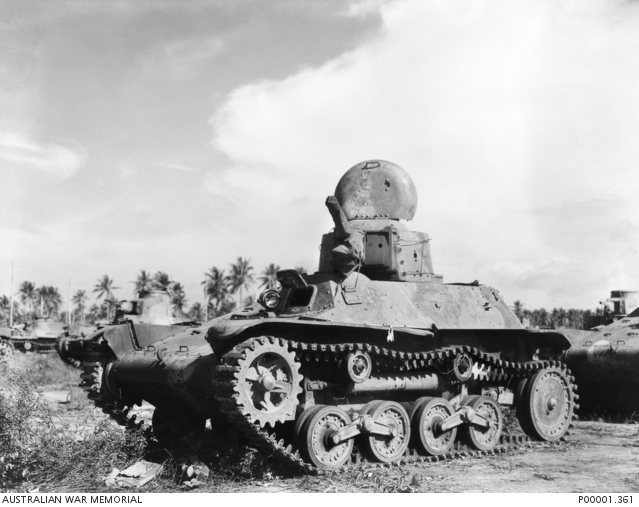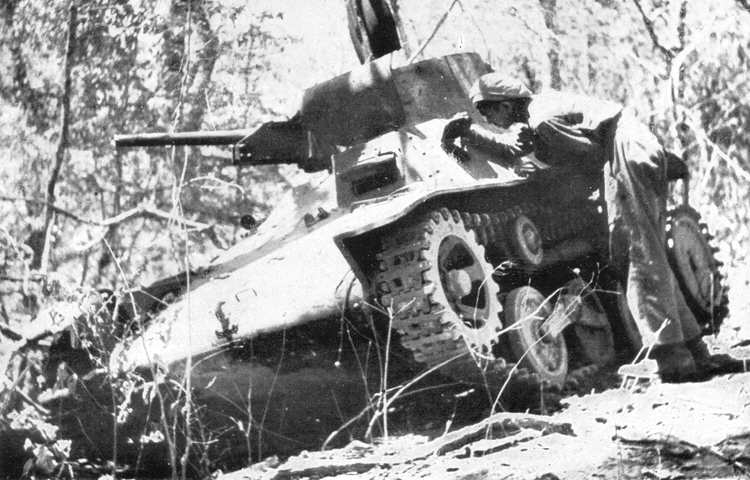The last Japanese tankette
Just like so many other countries, the Japanese military officials were ensnared by the tankette fad, during the thirties. The first model developed was the Jyu-Sokosha (1931), then came the mass-produced Type 94 TK (1933). The last evolution of the Japanese tankette was developed by the Hino Motors Company around a 4-cylinder diesel engine, and carried a 37 mm (1.46 in) gun, which was far more potent than the usual machine-gun. This prototype, built in 1936, was the very basis for the new Type 97, or 1938 according to the imperial calendar, after many tests and changes demanded by the Army. The final prototype, delivered in November, and finally accepted, entered full-scale production in 1938. They were designed to give additional fire support to infantry divisions, as well as many other tasks.Design of the Type 97 TK
The 1937 prototype was still largely based on the previous Type 94, and bore many similarities, starting with the drivetrain, although the engine was now located at the rear. Because of this, the fighting compartment was pushed forward, and the turret was now roughly in the middle. This put the driver and commander in close proximity, easing communication. The hull was still riveted, and the interior covered by heat absorbing asbestos sheets. The 37 mm (1.46 in) Type 94 main gun (L/36.7) was supplied with 94 rounds, had an elevation of -15/+20°, a 600 m/s (660 yd/s) muzzle velocity and could penetrate 45 mm (1.77 in) of armor at 300 meters (330 yd). This gun model, also shared with the Type 95 Ha-Go, was always in short supply, and many TKs ended with a Type 97 machine gun instead. Protection was limited to 16 mm of armor (0.63 in) on the front and turret, and was found inadequate against the HE rounds of the mainstream US M2 0.50 cal (12.7 mm) machine guns. The only known variant was the Type 98 So-Da, an ammo supply vehicle and APC.Operational history
Tactically, 6 tankettes were given to each IJN infantry division. They were primarily intended as scout vehicles, spearheading assaults. They also provided additional firepower where it was needed, and also supplied and/or towed light guns. Each was equipped with a reinforced towing hook. When production ended in 1941-42, a total of 596 or 557, depending on the source, had been produced, without any notable change. Most saw action in China, in various areas, until 1945. They were opposed by the Chinese National Revolutionary Army's few Italian CV-33 tankettes and French FT tanks, which did not seriously threaten the Type 97. However, on the Russo-Mongolian border they suffered heavy casualties, succumbing to the Russian high velocity 45 mm (1.77 in) gun, shared by the BT-5 and BT-7. During first months of the war in the Pacific, their lightweight characteristics were taken full advantage of when crossing small bridges or using wooden ferries. Their small dimensions allowed them to closely follow the infantry on narrow roads and tracks. They soldiered in Malaya, taking part in the fall of Singapore. Many were shipped to the Philippines, rarely opposed to American armor. But, when it was the case the M3 light tanks proved deadly.
Type 97 Te-Ke specifications |
|
| Dimensions (L-w-h) | 3.70 x 1.80 x 1.77 m (12 x 5.10 x 5.9 ft) |
| Total weight, battle ready | 4.7 tons (10,360 lbs) |
| Crew | 2 (driver, gunner/commander) |
| Propulsion | Hino Motors diesel air-cooled 4-cyl engine, 48 hp (36 kW) |
| Top speed | 42 km/h (26 mph) |
| Armor | 4 to 16 mm (0.16-0.63 in) |
| Armament | 37 mm (1.46 in) Type 94 gun or 7.7 mm (0.3 in) Type 97 machine-gun |
| Range (at cruise speed) | 250 km (155 miles) |
| Total production | 596 (557 ?) |

Type 97 Te-Ke, the machine-gun version, unknown infantry unit, Burma, 1942. Due to the shortage of 37 mm (1.46 in) guns, many were delivered in this undergunned configuration.

Type 97 Te-Ke gun version, Malaya, January 1942. This gun was also mounted on the Type 95 Ha-Go light tank.
Gallery



Get the Poster of the ww2 Imperial Japanese Army Tanks and support us !

WW2 Tanks




























WW2 tanks posters

All Tiger tanks liveries.

Panther liveries and variants

WW2 Armour - All tanks











Tanks aces and single tanks series

Find more there

Museums, Movies, Books & Games
The Tanks and Armor in pop culture
Tanks and armored vehicles in general are only really grasped when seen first person: The mass, the scale, it's all there. Explore also the way tanks were covered in the movie industry, in books and in video games.Movies:
Best tanks movie on warhistoryonline.com
On imdb.com
On bestsimilar.com/
miltours.com
liveabout.com/
watchmojo.com
Video Games:
pcgamesn.com
historyhit.com
levvvel.com
vg247.com/best-tank-games
mmobomb.com/
alienwarearena.com

